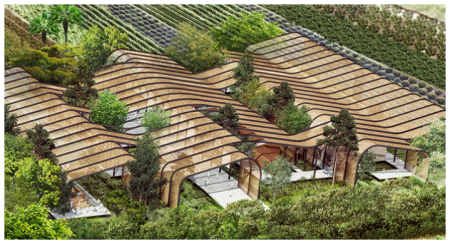- World Vegetable Centre looking for a genebank manager.
- What’s a grit?
- Who did you say saved parmesan? Who did you say is making gouda?
- Philippines gets some new rice varieties. No, but these are climate-resilient.
- A poisonous plants gardens fits perfectly with my mood today.
- Involve native people in the development of a native foods industry. Well, duh.
- Blame butterflies for broccoli.
- There are a lot of medicinal plants in the Amazon.
- Wild rice (wild but not rice) vs pipeline.
CIAT’s new genebank

Oh my. They’re not far off raising the required cash, apparently. Fingers crossed.
Nibbles: Pope, CGIAR, Agroecology, ABS, Food shortage, World flora, Nutella, Bees, GMOs, CC & wheat, CC & legumes, EU satellite, Seed saving, Wheat breeding, Strawberry breeding, Adopt-a-crop, Organic tea, Malagasy yams, Seed app, Ebola seeds, Sorghum spoons
And we’re back! While we were away…
- …the Pope pontificated on climate change and GMOs, among other things.
- And so did the CGIAR.
- Boffins in the UK suggested that agroecology might be important to sustainable intensification. No word on whether the CGIAR is listening.
- Bioversity asked for contributions on whether ABS can support farmers. No word on whether anyone is listening.
- And The Economist asked: who cares, anyway?
- Google said it would help botanists catalogue all plants.
- Nutella was bad, and then ok again.
- Bees were again found to be important to agriculture, but not all bees.
- The pros and cons of GMOs were trotted out again. And again.
- Climate change was blamed for smaller loaves of bread. Which as far as I can tell might not be a totally bad thing.
- And for the need to grow drought-resistant legumes.
- The EU launched a satellite to monitor crops.
- Meanwhile, people just got on with it, in their own, sometimes weird, way…
- …breeding wheat. Even organic wheat. Even perennial. Even in Scotland.
- …breeding strawberries. Even with wild relatives.
- …or just adopting the raw materials of breeding.
- Growing organic tea in China.
- Conserving yams in Madagascar.
- Trying to find the appropriate seeds to grow in Kenya.
- And giving probably inappropriate seeds to Ebola-hit farmers.
- Which they can now eat using sorghum spoons.
Brainfood: Eastern promise, Biodiversity databases, Pulse carotenoids, Castor oil breeding, Maya beans, NUS and water, Chinese Vitis
- An ethnobotanical perspective on traditional fermented plant foods and beverages in Eastern Europe. 116 taxa, with a preponderance of Rosaceae.
- Estimating species diversity and distribution in the era of Big Data: to what extent can we trust public databases? Trust, but verify.
- Genetic diversity of nutritionally important carotenoids in 94 pea and 121 chickpea accessions. There’s carotenoid diversity in the Canadian collections.
- Role of conventional and biotechnological approaches in genetic improvement of castor (Ricinus communis L.). We have the technology. What we don’t have is results.
- Phaseolus from Cerén—A Late Classic Maya Site. The wilds were also eaten.
- The Potential Role of Neglected and Underutilised Crop Species as Future Crops under Water Scarce Conditions in Sub-Saharan Africa. Some neglected species may be somewhat adapted to low water conditions, perhaps.
- The wild relatives of grape in China: Diversity, conservation gaps and impact of climate change. 15 of 39 species need help, especially as the range of many is expected to be reduced by climate change.
Fun ePhyto facts
I really look forward to receiving Fresh, the AVRDC Newsletter, every month. There’s always at least one thing of interest, which is all you can ask for in a newsletter. I would prefer that clicking on a link in the email alert took me to the full online version of the article I want to read, rather than to a big pdf to download and wade through, but I won’t quibble.
The article that caught my eye on this occasion was this one:
The creation of a new global electronic certification system that will help curb the spread of plant pests and diseases through international trade in a more secure and cost-effective way has been approved by representatives from 181 countries.
The Commission on Phytosanitary Measures (CPM), the governing body of the International Plant Protection Convention (IPPC), agreed in March 2015 to develop a global system of electronic phytosanitary certificates, known as ePhyto. The complex, bureaucratic process whereby millions of paper phytosanitary certificates are created, printed, and exchanged between countries each year will eventually be replaced by this online system. The current paper certificates serve to reassure importers that plant products, including food, have been inspected and found to be free of pests that could devastate local economies by harming agriculture or the environment.
ePhyto is expected to simplify and reduce the cost of global trade, increase the ability of countries to identify items that pose a high risk, and reduce the potential for fraud. The CPM endorsed a request to the Standards and Trade Development Facility of the World Trade Organization (WTO) to provide funds for the initial establishment of ePhyto.
The IPPC is also planning a pilot project to build capacity in developing countries to enable them to join ePhyto on a gradual basis. Several countries are already using some form of electronic certification, including Australia, Canada, Kenya, the Republic of Korea, the Netherlands, New Zealand and the United States.
Will be interesting to see if this makes life any easier for genebanks distributing germplasm. And I wonder whether we’ll eventually see integration of this system with that of the SMTA.
But anyway, don’t let me stop you reading the whole newsletter. There’s other fun stuff in there, for example a story about a new African eggplant variety that’s making quite a splash.
